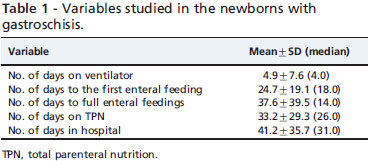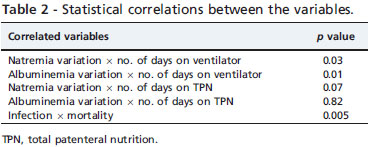OBJECTIVES AND INTRODUCTION: Gastroschisis is a congenital abdominal wall defect with increasing occurrence worldwide over the past 20-30 years. Our aim was to analyze the morbidity of newborns after gastroschisis closure, with emphasis on metabolic and hydroelectrolyte disturbances in patients at three tertiary university centers. METHODS: From January 2003 to June 2009, the following patient data were collected retrospectively: (A) Background maternal and neonatal data: maternal age, prenatal diagnosis, type of delivery, Apgar scores, birth weight, gestational age and sex; (B) Surgical modalities: primary or staged closure; and (C) Hospital course: levels of serum sodium and levels of serum albumin in the two first postoperative days, number of ventilation days, other postoperative variables and survival. Statistical analyses were used to examine the associations between some variables. RESULTS: 163 newborns were included in the study. Primary closure of the abdominal defect was performed in 111 cases (68.1%). The mean serum sodium level was 127.4¡6.7 mEq/L, and the mean serum albumin level was 2.35¡0.5 g/dL. Among the correlations between variables, it was verified that hyponatremia and hypoalbuminemia correlated with the number of days on the ventilator but not with the number of days on total parenteral nutrition (TPN); mortality rate correlated with infection. The final survival rate was 85.9%. CONCLUSION: In newborns with gastroschisis, more aggressive attention to hyponatremia and hypoalbuminemia would improve the outcome.
Gastroschisis; Gastroschisis repair; Preterm; Morbidities; Neonates; Body wall defects





